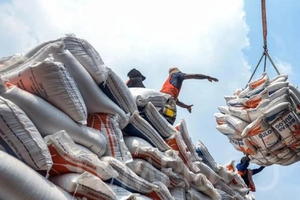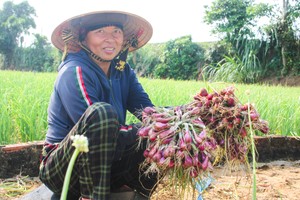In coastal areas of Ben Tre Province, after mass die-off of thousands of tons of clams, cooperatives and farmers have cleaned up the farming areas to prevent pollution and are closely monitoring the salinity level to wait for favorable conditions to increase clam farming for export.
In Soc Trang Province, Mr. Vo Van Choi, Chairman of the People’s Committee of Ngoc To Commune in My Xuyen District, said that in the past months, due to high salinity levels, nearly 1,900 hectares of shrimps were behind schedule. To prevent losses, authorities recommended farmers to raise shrimps perfunctorily and sparsely with low density. At the same time, farmers should closely monitor and wait for the salinity to decline before increasing shrimp farming in the future.
According to Mr. Nguyen Van Quoc, Deputy Head of the Department of Fisheries of Tra Vinh Province, every year, the province raises 25,000 hectares of shrimps but this year, the raising ratio merely accounts for 30 percent of that in the same period last year. Currently, the industry has been zealously supporting farmers with production plans. When the weather is stable and the prices of shrimps increase, the area of shrimps will be recovered rapidly.
Meanwhile, Deputy Minister Le Quoc Doanh of the Ministry of Agriculture and Rural Development said that the winter-spring rice crop in the Mekong Delta is completed successfully with rice yield at 10.7 million tons of rice and a profit of 30-40 percent for farmers. However, some places were subjective and lacked close cooperation, and farmers lacked information so they did not sow rice as recommended; the crop calendar was not checked regularly and the source of water was not reviewed thoroughly so the crop structure remained clumsy. As a result, Mekong Delta provinces had more than 33,800 hectares of winter-spring rice being affected by saltwater intrusion and drought at different degrees. Although the loss is much lower than that in 2016, they need to learn from the experience to organize production more reasonably in the next crops.
According to the forecast by the Southern Institute of Water Resources Research, during the first day of April this year, the salinity level will drop but since mid-April, saltwater intrusion in the Mekong Delta will increase again, then possibly decline quickly at the end of April at estuaries. Therefore, local authorities and the agricultural sector need to closely watch the developments of saltwater intrusion to actively promote production when it is eligible.
The MARD said that saltwater intrusion and drought this year will break the record level in 2016. Despite active measures, some losses on rice, vegetables, and aquatic products are inevitable. It is forecast that, by mid-April, after the saltwater intrusion increases, the situation will ease. Therefore, provinces need to focus on directing the production of more than 1.5 million hectares of summer-autumn rice to ensure a target of more than 8.7 million tons of rice. Moreover, Mekong Delta provinces need to make plans for the autumn-winter rice crop early with about 750,000 hectares under the condition that small floods are forecast to not affect rice production.
In Soc Trang Province, Mr. Vo Van Choi, Chairman of the People’s Committee of Ngoc To Commune in My Xuyen District, said that in the past months, due to high salinity levels, nearly 1,900 hectares of shrimps were behind schedule. To prevent losses, authorities recommended farmers to raise shrimps perfunctorily and sparsely with low density. At the same time, farmers should closely monitor and wait for the salinity to decline before increasing shrimp farming in the future.
According to Mr. Nguyen Van Quoc, Deputy Head of the Department of Fisheries of Tra Vinh Province, every year, the province raises 25,000 hectares of shrimps but this year, the raising ratio merely accounts for 30 percent of that in the same period last year. Currently, the industry has been zealously supporting farmers with production plans. When the weather is stable and the prices of shrimps increase, the area of shrimps will be recovered rapidly.
Meanwhile, Deputy Minister Le Quoc Doanh of the Ministry of Agriculture and Rural Development said that the winter-spring rice crop in the Mekong Delta is completed successfully with rice yield at 10.7 million tons of rice and a profit of 30-40 percent for farmers. However, some places were subjective and lacked close cooperation, and farmers lacked information so they did not sow rice as recommended; the crop calendar was not checked regularly and the source of water was not reviewed thoroughly so the crop structure remained clumsy. As a result, Mekong Delta provinces had more than 33,800 hectares of winter-spring rice being affected by saltwater intrusion and drought at different degrees. Although the loss is much lower than that in 2016, they need to learn from the experience to organize production more reasonably in the next crops.
According to the forecast by the Southern Institute of Water Resources Research, during the first day of April this year, the salinity level will drop but since mid-April, saltwater intrusion in the Mekong Delta will increase again, then possibly decline quickly at the end of April at estuaries. Therefore, local authorities and the agricultural sector need to closely watch the developments of saltwater intrusion to actively promote production when it is eligible.
The MARD said that saltwater intrusion and drought this year will break the record level in 2016. Despite active measures, some losses on rice, vegetables, and aquatic products are inevitable. It is forecast that, by mid-April, after the saltwater intrusion increases, the situation will ease. Therefore, provinces need to focus on directing the production of more than 1.5 million hectares of summer-autumn rice to ensure a target of more than 8.7 million tons of rice. Moreover, Mekong Delta provinces need to make plans for the autumn-winter rice crop early with about 750,000 hectares under the condition that small floods are forecast to not affect rice production.
























